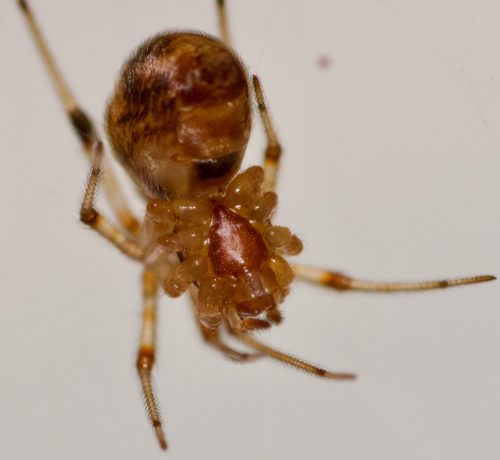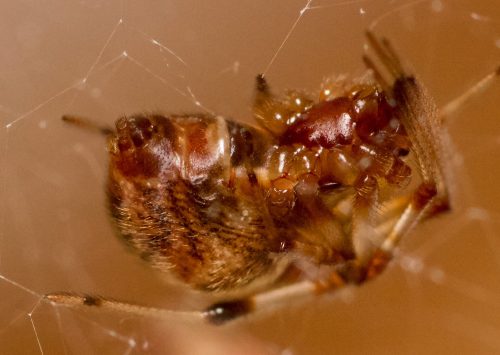Arachnologists spend a lot of time staring at spider genitals, since they’re often key to classifying them. I’ve mentioned that I want to work out some taxonomic ignorance of my own, so I’m finding myself trying to do likewise. This morning I was working with my shiny new toy to see if I could resolve the important details with an SLR tricked out with a 100mm macro lens and 65mm of extension tubes. This represents the maximum magnification I can squeeze out of this set up, short of mounting the animals under the microscope, which would give me hella more magnification.
I’d rather not go that route, though, because it requires more manipulation of the animals and I’d rather keep them happy and relaxed. Right now in their cages, they lounge about upside down, all quiet and mellow, their legs spread out and flaunting their genitalia to the sky. I can just pop the lid and zoom in with my camera lens and they’re totally unperturbed and au naturale, exposed and waiting for their close-up. This would also be the case if I encountered them in the wild, where I’m typically not lugging a microscope around with me. The hope is that my camera would have enough oomph to get all the diagnostic details.
Long story short…probably not. I’ll throw in a few photos below the fold, but they aren’t quite good enough to see what I need to see.
What I need to resolve is in the dark pigmented area of the anterior abdomen where her feminine mystery is located. The lighting isn’t bad, but I can’t quite peer in closely enough.
Meanwhile, this one has posed with her third left limb shyly veiling her zone. There are hints of structure there, but even if she wasn’t trying to be modest I don’t think I could get a crisp enough examination.
Oh, well, it’s fun trying. Even with all the extension tubes in, I’m still dazzled by how much working distance this lens gives me. Unfortunately, I’m beginning to understand why all the real arachnologists fix and clear and dissect to get good look at what’s going on in this region, and I guess I need to be a spider gynecologist/pathologist rather than a spider pornographer.
My current plan, then, is to do a post-mortem classification after they die of natural causes, which will also identify the species of all their offspring. Alternatively, I could also do breeding experiments to at least divide my colony into groups, although there the concern would be that maybe I’d get hybrids and totally confuse everything.
Maybe male pedipalps would be more accessible features for classification?




Fuzzy and adorable
It looks as though both photos might have slightly soft focus in the area that you are trying to resolve. The first photo shows sharp detail on the sternum, but the dark patch posterior of that is soft.
At that distance, millimeters matter. Are you using a tripod? Are you using spot focus? If they are sitting still, you should be using both of those and maybe even manually focusing the lens. You might also try a low intensity high pass soft or hard light filter when processing.
It also looks as though the exposure highlighted the tan areas which probably lost you the detail of the darker areas. Try over exposing the light areas to get more detail in the dark. Setting the camera to spot meter might also help. What camera body are you using?
Spider porn…
https://www.flickr.com/photos/43412816@N04/albums/72157635363794677
After a year or two absence, we had a garden spider make its home in our back yard this year.
I would go check up on her and take a picture or two. Except for the occasional wrapped up meal, I got nothing really interesting other than the ‘ol ‘look at the spider in the web’ pic. Same as it ever was.
Then one day a male showed up with a small web perpendicular to hers. ( see pic 6 ) Two days later, he was on her web sitting off to her side. ( see pic 9 )
On day 4 the show started. He was moving all over her web, front and back, side to side. All of a sudden she was curled up ( see pic 12 ) and I was suddenly worried about the female. He was still moving all over the place and it looked like he was touching her with his legs, but it took me a few minutes to figure out what was happening.
She was molting. ( see pic 15 ) You can just make out the skin off the top of her head. The male was all over the place during this molting process and I guess he might have been helping her.
10 minutes after she first curled up and started the molting process, the male made his move. ( see pic 21 ) She is still not finished, her legs are still in their old skin, but the male has started his part of the mating process.
Over the next few minutes, she gets her legs free, just sort of hangs there for a bit, then get some movement back, and towards the end of the mating process assumes her usual stance on the web.
The male seemed to crawl away and die. He was curled up near her and did not move again. His body and her old skin where found underneath her web the next day.
A few days later we had a really long and hard rain. There is no sign of her or her web.
And so it goes…
Let’s not succumb to the dark side and start doing spider snuff porn. Anyway, some people are really into the raw, amateur look.
Agree with 3.
Just spitballing here:
From the data (iso 800, f/8, 1/60) I’m guessing that you’re bumping up against the edge of your comfort zone, which you can probably push. May need a few more exposures if your spiders can stand it.
Have you tried using one of those little goose-neck lamps? Or you might be able to paint the area with a tightly focused flashlight beam.
I’ve noticed that on some of your photos your data notes that you’ve used GIMP, but I’m not seeing that listed in this one. I’m wondering if you captured in JPEG at this resolution, because that dark area is heavily pixelated on zooming in. If you capture at your highest resolution in RAW format (or TIFF, I can’t remember if GIMP does RAW) you’ll have more to work with in GIMP where you can play with curves, levels, etc. to make the details more recognizable to human eyes.
That’s my 2 cents worth.
I’d recommend learning about focus stacking.
I’ve kind of given up on GIMP — it’s an ugly, buggy program that’s gotten even buggier with the latest system update. I’m using Apple’s Photos program. All photos are captured in RAW, tweaked in Photos, then I use Preview to chop the size down to 1500×1000 pixels for posting here, just to limit the size for storage and display.
I’ve got a couple of LED lights I can use, but the catch is that I want to minimize manipulation of the animals, and already I’m hauling in a surplus of gear. On my future wishlist are some remote speedlites & wireless trigger so I can get more control of the lighting.
I’ve also got a ring light I could mount on the lens, but then I run into another problem: this lens + the extenders puts a lot of weight out there on a long arm, and adding the ring light…man, I’m going to need a year of working with weights to build up my strength.
Not using a tripod, either, because I want flexibility in angling the photos. I may have to change that, though, because, again, my limp spaghetti muscles are reaching a limit.
I know about focus stacking, and have been looking into that, too. I’m poor, though, and can’t afford any of the commercial software out there.
Do the molted shells retain any genital evidence of the species?
Oooh, that’s an interesting idea. I’ll have to look.
BTW, you’re in academia. You should be able to purchase Photoshop very cheap with your university affiliation. I bought the complete CS5 suite for something ridiculous, like $100. Individual pieces were somewhere around $25. Not sure what kind of discounts they give for CC as I’m still using the standalone CS5 which works just fine.
All standalone versions of Photoshop have been discontinued. You can only buy subscriptions now.
PZ, the wiki page lists several free software options for focus stacking, but two are only for Windows, one for Linux. On an Apple, that at least leaves you with Enblend-Enfuse and ImageJ, if not others that may not be listed there.
Not a photographer and I can’t vouch for them. Also, I’m not a fan of spiders.
GIMP may not be perfect, but if you need better image editing tools than Apple Photos can offer, it’s your best option as far as I’m aware. Myself, I only have to use it (the Windows version) occasionally and usually not to do anything terribly sophisticated, but I’m happy with it.
Huh. I have ImageJ and use it a fair bit…I didn’t know it did focus stacking, but I’ll give it a try.
GIMP has a number of issues that reveal that whoever is programming it isn’t very good at the MacOSX side of things. For instance, it constantly loses focus: you want to save something, it opens up the usual file dialog box, but it still thinks some other window is in front, so you can’t click on anything in the dialog box until you do this roundabout thing of clicking a different window to bring it forward, then finding the dialog box and clicking on that so that the stupid thing finally figures out which window you’re using. At times the whole thing becomes unusable because who knows what it thinks you’re interacting with.
I realize that Adobe’s stuff is all subscription now, but they do have student and teacher pricing. Currently, you can get the entirety of creative cloud at $20/mo, $30/ mo after the first year. Probably more than you want to spend, but it is an option.
It’s a shame they don’t offer subs for just Photoshop as I’m sure you don’t need all the other stuff.
I did find that you can get single apps for education for $15/mo/license:
https://www.adobe.com/creativecloud/education-plans.html
Oh…and you can get a 30-day trial to see if you like it, if you’ve never used Photoshop before. It’s the gold standard for image editing for a reason.
*no, I don’t work for Adobe :-)
imagej — looks like there’s a plug-in: “stack focuser”
may be others
For your exposure problem you may need HDR instead of focus stacking.
If you’re on a Mac, take a look at Affinity photo (at the App Store). It’s relatively inexpensive and no subscription is required. You may be able to get by without PhotoShop.
My experience with Affinity so far is that whatever bugs it may have, none of them affect anything I care about.